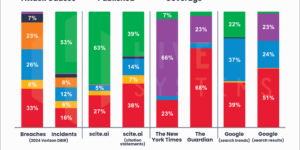As investigators sift through the charred wreckage of a jetliner that crashed shortly after takeoff from Tehran, contradictory reports have emerged about what might have caused the Boeing Co. 737-800 to abruptly plunge out of the sky.
Iranian authorities initially blamed “technical” causes then said an engine fire most likely led to the loss of Ukraine International Airlines Flight 752, killing all 176 people on board. The Ukrainian embassy in Tehran at first ruled out terrorism, then amended its statement to offer no comment on possible causes.
Given that the crash on Wednesday came hours after a barrage of Iranian missiles were fired on U.S. bases in Iraq, speculation also turned to a possible accidental attack by Tehran’s own air defense system.
The recently serviced, three-year-old jet went down without a distress call and after its global-positioning transmissions were cut off mid-air — unusual for a crash. A video purportedly shot by a bystander shows flames coming from the jet as it streaked across the night sky and burst into a fireball on impact.
“The plane is on fire,” an unidentified male voice can be heard on the video. “In the name of God, God help, call the firefighters.”
Meanwhile, the investigation is being hampered by the tension between Iran and the U.S.
The U.S. National Transportation Safety Board, which would normally be invited to participate in a crash of a U.S.-built jetliner, issued a cautious statement saying it is monitoring the situation. Long-existing U.S. sanctions against Iran require the NTSB to seek special permission to participate in any investigations in that country.
Iran’s Disaster Mitigation and Management Organization said early assessments indicated the cause was a technical issue, while the transport ministry suggested an engine fire was involved.
A veteran aviation accident investigator said the flight-tracking data and amateur video were unlike a typical engine failure or fire scenario. While the evidence is still sparse, it’s far more suggestive of a bomb or missile, said Jeffrey Guzzetti, former chief of the U.S. Federal Aviation Administration’s accident investigation division.
“Airplanes don’t just catch fire and have that fire spread like that in such a short period of time, unless there was an intentional act causing that fire and explosion,” Guzzetti said in an interview.
The tragedy recalled the 2014 downing of a Malaysia Airlines jet by a surface-to-air missile during the conflict over Crimea, eventually blamed by investigators on pro-Russia rebels. Complicating matters, Iranian officials haven’t been clear about how much access U.S. experts will be given to the probe, or to the 737’s flight data recorders.
Ghasem Biniaz, the head of communications for Iran’s Ministry of Roads and Urban Developments, said reports of a missile attack are false, IRNA reported.
A state-run news outlet cited an official at Iran’s Civil Aviation Organization as saying the pilots didn’t declare an emergency.
If the amateur video turns out to be genuine, it indicates the plane was essentially a fireball as it plunged, Guzzetti said. Bright lights emanating from the aircraft suggest explosions as well, he said.
Two other aviation safety experts urged caution about jumping to conclusions.
“I wouldn’t take anything off the table right now,” said John Cox, a former airline pilot who is president of Safety Operating Systems. When asked about the potential for a bomb or missile, Cox said, “Certainly they are going to look at external forces.”
It’s at least theoretically possible for a fast-moving cargo fire to take down a plane, said Roger Cox, a former NTSB investigator. A ValuJet plane crashed in Florida in 1996 after pure oxygen caused a raging inferno, he said. But even in that case, the plane flew for about 10 minutes, far longer than the Ukrainian plane.
Ukraine International said 167 passengers and nine crew were on the 737, an older version of Boeing’s narrow-body workhorse that predates the Max model that was grounded last year following two fatal crashes.
The model involved in the Iranian crash doesn’t use the flight control system implicated in the Max tragedies and has one of the best safety records of any jetliner.
The Ukrainian jet lifted off and climbed to about 7,900 feet and was traveling at roughly 300 miles an hour when it stopped transmitting its position and disappeared, according to data supplied by FlightRadar24. Other aircraft operating out of Tehran were tracked normally, said FlightRadar24 spokesman Ian Petchenik.
The plane came down at 6:18 a.m. Wednesday in Sabashahr, near the Iranian capital.
Television footage showed recovery efforts at the crash site, with debris spread across a charred field. Ukraine’s foreign ministry said about half those on board held Iranian citizenship and that there were more than 60 Canadian citizens, as well as Swedes, Afghans, Britons and Ukrainians.
Canada’s Transportation Safety Board said it has appointed an expert to review facts released by Iran and monitor the progress of the investigation.
“Our government will continue to work closely with its international partners to ensure that this crash is thoroughly investigated, and that Canadians’ questions are answered,” Canadian Prime Minister Justin Trudeau said in a statement.
Ukraine International Vice President Ihor Sosnovskyi said in Kyiv that the plane, delivered to the airline new in 2016, was in good condition and had its last shop visit on Jan. 6. He said the crew was also very experienced and that there were no indications of human error, while declining to comment on possible reasons for the crash, the company’s first since it was set up in 1992.
Under established protocols, Iran would lead any investigation because the crash occurred on its soil. Ukraine Prime Minister Oleksiy Honcharuk said his government has informed Iran that its experts should take part.
Few nations have the expertise and technical facilities to conduct a full accident probe, however, so the U.S., France, Britain or other countries have provided assistance in the past. The plane’s crash-proof recorders will have to be downloaded in a specialist lab.
International rules for air-crash probes mean the countries that made the plane and its engines usually participate, providing technical expertise. But the current turmoil between Iran and the U.S. may complicate the involvement of the NTSB and Boeing.
Black Boxes
“Accident investigations should stand above politics,” Safety Operating Systems’ John Cox said. “I’m hopeful that all the governments will put politics aside and let a transparent accident investigation take place.”
Hassan Rezaeifar, head of the Iranian Civil Aviation Organization’s accident-investigation office, said it’s for Iran to decide how and where the plane’s so-called black boxes are decoded, “as per the law,” according to the semi-official ISNA news agency.
Reza Jafarzadeh, a spokesman for the aviation organization, told Bloomberg News that his nation observes international protocols, and that Ukraine, “as well as the planemaker,” can take part in the probe.
France’s BEA hasn’t been contacted for assistance but has helped Iran in the past, said a spokesman, Sebastien Barthe.
The tragedy comes at a tense time for both Iran and Boeing.
The Islamic republic fired more than a dozen missiles at U.S. bases in retaliation for the killing of Iran’s top general, Qassem Soleimani. Just prior to the crash, U.S. aviation regulators issued new restrictions barring civilian flights over Iraq and Iran.
The U.S. State Department issued a statement offering assistance to Ukraine. “The United States calls for complete cooperation with any investigation into the cause of the crash,” according to the statement.
Boeing is still gripped by one of the worst crises in its 103-year history after the two Max disasters led to the grounding of that fleet in March. The company said in a statement that its thoughts are with crew, passengers and their families after the tragedy, without commenting on the cause. The planemaker’s stock declined 1.7% to $331.68 at 3:53 p.m. in New York.
Engines for the single-aisle plane are made by CFM International, a joint venture of General Electric Co. and Safran SA. A representative didn’t comment on the details or possible cause of the crash but said by email that CFM extends “heartfelt sympathies to the families and loved ones of those on board.”
(Updates with additional detail and commentary by experts, beginning in fifth paragraph)
–With assistance from Harry Suhartono, Kyunghee Park, Anurag Kotoky, Eduard Gismatullin, Angus Whitley, Layan Odeh, Paul Dobson, Will Davies, Rudy Ruitenberg, Volodymyr Verbyany, Julie Johnsson and Richard Clough.




















 Insurance Carrier Employees Are Bored; Most Boring Rankings Published
Insurance Carrier Employees Are Bored; Most Boring Rankings Published  Moderating Premium Rates, Falling Yields: European Insurers Resilient
Moderating Premium Rates, Falling Yields: European Insurers Resilient  Four P/C Insurers Are ‘AI Titans’; AI Impact Leaders Revealed: Research
Four P/C Insurers Are ‘AI Titans’; AI Impact Leaders Revealed: Research  Weak La Nina Expected in the Central Region of the U.S. This Winter: NWS
Weak La Nina Expected in the Central Region of the U.S. This Winter: NWS 







